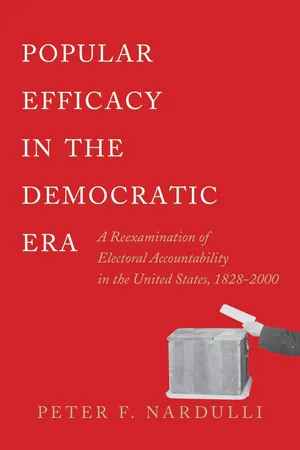
Popular Efficacy in the Democratic Era
A Reexamination of Electoral Accountability in the United States, 1828-2000
- 272 pages
- English
- PDF
- Available on iOS & Android
Popular Efficacy in the Democratic Era
A Reexamination of Electoral Accountability in the United States, 1828-2000
About This Book
Social scientists have long criticized American voters for being "unsophisticated" in the way they acquire and use political information. The low level of political sophistication leaves them vulnerable to manipulation by political "elites, " whose sway over voters is deemed incontrovertible and often decisive. In this book, Peter Nardulli challenges the conventional wisdom that citizens are "manageable fools, " with little capacity to exercise independent judgment in the voting booth. Rather, he argues, voters are eminently capable of playing an efficacious role in democratic politics and of routinely demonstrating the ability to evaluate competing stewards in a discriminating manner.
Nardulli's book offers a cognitively based model of voting and uses a normal vote approach to analyzing local-level election returns. It examines the entire sweep of United States presidential elections in the democratic era (1828 to 2000), making it the most encompassing empirical analysis of presidential voting to date. Nardulli's analysis separates presidential elections into three categories: those that produce a major, enduring change in voting patterns, those that represent a short-term deviation from prevailing voting patterns, and those in which the dominant party receives a resounding endorsement from the electorate. These "disequilibrating" elections have been routine in American electoral history, particularly after the adoption of the Progressive-Era reforms. Popular Efficacy in the Democratic Era provides a dramatically different picture of mass-elite linkages than most prior studies of American democracy, and an image of voters as being neither foolish nor manageable. Moreover, it shows why party elites must take proactive steps to provide for the core political desires of voters.
Frequently asked questions
Information
Table of contents
- Cover
- Title
- Copyright
- Dedication
- CONTENTS
- Preface
- Acknowledgments
- CHAPTER ONE: Democracy, Popular Efficacy, and the Electoral Arena
- CHAPTER TWO: Democratic Citizenship, Democratic Citizens, and Mass-Elite Linkages
- CHAPTER THREE: Exogenous Events, Evaluations of Stewardship, and Citizens’ Normal Voting Behavior
- CHAPTER FOUR: Endogenous Influences and the Evaluative Capacities of Democratic Citizens
- CHAPTER FIVE: Conceptual and Methodological Foundations for a Reexamination of Popular Efficacy
- CHAPTER SIX: The Roots of Partisanship: Party Elites, Exogenous Groups, and Electoral Bases
- CHAPTER SEVEN: Partisan Realignments and Electoral Independence: The Incidence, Distribution, and Magnitude of Enduring Electoral Change
- CHAPTER EIGHT: Electoral Perturbations and Electoral Independence: Stewardship, Partisanship, and Accountability
- CHAPTER NINE: The Electoral Impact of Departures from Normal Voting Patterns: Electoral Jolts and the Aspirations of Political Elites
- CHAPTER TEN: Popular Efficacy in the Democratic Era
- Index